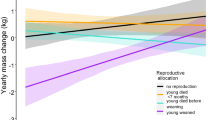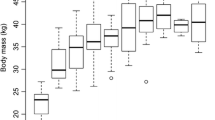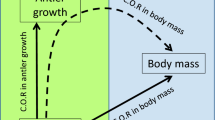Abstract
I examined the relationship between age, body size and fecundity in 833 female moose (Alces alces) from 14 populations in Sweden sampled during 1989–1992. Data on population density, food availability and climatic conditions were also collected for each population. Age and body mass were both significantly positively related to fecundity, measured as ovulation rate, among female moose. The relationship between the probability of ovulation and body mass was dependent on age with (1) a higher body mass needed in younger females for attaining a given fecundity, and (2) body mass having a stronger effect on fecundity in yearling (1.5 year) than in older (≥2.5 year) females. Thus, a 40 kg increase in yearling body mass resulted in a 42% increase in the probability of ovulation as compared to a 6% increase in older females. The lower reproductive effort per unit body mass, and the relatively stronger association between fecundity and body mass in young female moose compared to older ones, is likely to primarily represent a mechanism that trades off early maturation against further growth, indicating a higher cost of reproduction in young animals. In addition to age and body mass, population identity explained a significant amount of the individual variation in fecundity, showing that the relationship between body mass and fecundity was variable among populations. This variation was in turn related to the environment, in terms of climatic conditions forcing female moose living in relatively harsh/more seasonal climatic conditions to attain a 22% higher body mass to achive the same probability of multiple ovulation (twinning) as females living in climatically milder/less seasonal environments. The results suggests that the lower fecundity per unit body mass in female moose living in climatically harsh/more seasonal environments may be an adaptive response to lower rates of juvenile survival, compared to females experiencing relatively milder/less seasonal climatic conditions.
Similar content being viewed by others
References
Ahti T, Hämet-Ahti L, Jalas J (1968) Vegetation zones and their sections in northeastern Europe. Ann Bot Fenn 5:169–211
Albon SD, Langvatn R (1992) Plant phenology and the benefit of migration in a temperate ungulate. Oikos 65:502–513
Albon SD, Mitchell B, Staines BW (1983) Fertility and body weight in female red deer: a density-dependent relationship. J Anim Ecol 52:969–980
Albon SD, Mitchell B, Huby BJ, Brown D (1986) Fertility in female red deer (Cervus elaphus): the effect of body composition, age and reproductive status. J Zool Lond 209:447–460
Bernardo J (1993) Determinants of maturation in animals. Trends Ecol Evol 8:166–173
Boyce MS (1978) Climatic variability and body size variation in the muskrats (Ondatra zibethicus) of North America. Oecologia 36:1–19
Boyce MS (1979) Seasonality and patterns of natural selection for life histories. Am Nat 114:569–583
Boyce MS (1988) Evolution of life histories of mammals-theory and pattern. Yale University Press, New Haven
Cameron GN, McClure PA (1988) Body size patterns in North American mammal faunas. In: Boyce MS (ed) Evolution of Life histories of Mammals, Yale University Press, New Haven, pp 33–64
Caswell H (1989) Matrix population models. Sinauer, Sunderland, Mass
Cederlund G, Sand H, Pehrson Å (1991) Body mass dynamics of moose calves in relation to winter severity. J Wildl Manage 55:675–681
Clutton-Brock TH (1991) The evolution of parental care. Monographs in behavior and ecology. Princenton University Press, NJ
Clutton-Brock TH, Albon SD (1989) Red deer in the Highlands. Blackwell Scientific, Oxford
Clutton-Brock TH, Albon SD, Guinness FF (1988) Reproductive, success in male and female red deer. In: Clutton-Brock TH (ed) Reproductive success. University of Chicago Press, chicago
Engen S, Saether B-E (1994) Optimal allocation of resources to growth and reproduction. Theor Popul Biol 46:232–248
Gadgil M, Bossert W (1970) Life history consequences of natural selection. Am Nat 104:1–24
Gaillard J-M, Sempéré AJ, Boutin J-M, Laere GV, Boisaubert B (1992) Effects of age and body weight on the proportion of females breeding in a population of roe deer (Capreolus capreolus). Can J Zool 70:1541–1545
Geist V (1987) Bergmann's rule is invalid. Can J Zool 65:1035–1038
Hosemer DW, Lenenshow S (1989) Applied logistic regression. Wiley, New York
Klein DR (1965) The ecology of deer range in Alaska. Ecol Monogr 35:259–284
Klein DR (1970) Tudra ranges north of the Boreal Forest. J Range Manage 23:8–14
Klein DR (1985) Population ecology: the interaction between deer and their food supply. In: The biology of deer production. R Soc NZ Bull 22:13–22
Kozlowski J, Uchmanski J (1987) Optimal individual growth and reproduction in perennial species with indeterminate growth. Evol Ecol 1:214–230
Lanestedt G, Pederssen PH, Nordhuus I, Jaren V, Anderssen JE, Saether B-E (1988) A population model for moose management. Part 1–2 CERSIM-evaluated (in Norwegian). Directory for Nature Management, Trondheim
Langvatn R, Albon SD (1986) Geographic clines in body weight of Norwegian red deer: a novel explanation of Bergmann's rule? Holarct Ecol 9:285–293
Langvatn R, Albon SD, Burkey T, Clutton-Brock TH (1994) Climate, plant phenology, and variation in age of first reproduction in a temperate herbivore. In: R Langvatn (PhD thesis) Climate-associated variation in the resource base for red deer (Cervus elaphus)-relationships to body size and reproductive per formance within and between cohorts. University of Oslo, Oslo
Law R (1979) Optimal life histories under age-specific predation. Am Nat 114:399–417
Lenvik D, Granefjell O, Tamnes J (1982) Calf mortality in a new perspective. (in Norwegian). Scandinavian Reindeer Meeting, Hemavan 1981 (supplement to Rangifer), pp 1–82
Markgren G (1969) Reproduction of moose in Sweden. Swed Wildl 6:127–299
Mech LD, Nelson ME, McRoberts RE (1991) Effects of maternal and grandmaternal nutrition on deer mass and vulnerability to wolf predation. J Mammal 72:146–151
Michod ED (1970) Evolution of life histories in response to age specific mortality factors. Am Nat 113:531–550
Pianha ER (1970) On r- and K-selection. Am Nat 104:592–597
Porter WP, McClure PA (1984) Climate effects on growth and reproduction potential in (Sigmodon hispidus) and (Peromyscus maniculatus.) In: JF Merrit (ed) Winter ecology of small mammals. Special Publication of the Carnegie Museum of Natural History 10, Pittsburgh
Reimers E (1983) Reproduction in wild reindeer in Norway. Can J Zool 61:211–217
Riley H, Skjelvåg AO (eds) (1984) The impact of grass production and quality. Proceedings of the 10th general meeting of the European Grassland Federation, Ås, Norway
Roff DA (1988) The evolution of migration and some life history parameters in marine fishes. Environ Biol Fishes 22:133–146
Roff DA (1992) The evolution of life histories: theory and analyses. Chapman and Hall, New York
Sadleir RMFS (1969) The ecology of reproduction in wild and domestic animals. Methuen, London
Saether B-E, Hagenrud H (1983) Life history of the moose Alces alces: fecundity rates in relation to age and carcass weight. J Mammal 64:226–232
Saether B-E, Hagenrud H (1985) Life history of the moose Alces alces: relationship between growth and reproduction. Holarct Ecol 8:100–106
Sand H, Cederlund G, Danell K (1995) Geographical and latitudinal variation in growth patterns and adult body size of Swedish moose (Alces alces). Oecologia 102:433–442
Schaffer WM (1974) Selection for optimal life histories: the effects of age structure. Ecology 55:291–303
Simpson MR, Boutin S (1993) Muskrat life history: a comparsion of a northern and southern population. Ecography 16:5–10
Skogland T (1984) The effect of food and maternal condition on fetal growth and size in wild reindeer. Rangifer 4:39–46
Skogland T (1989) Natural selection of wild reindeer life history traits by food limitation and predation. Oikos 95:101–110
Skunke F (1949) The moose-studies, harvest and management (in Swedish). Nordstedts, Stockholm
Stearns SC (1992) The evolution of life histories. Oxford University Press, Oxford
Stearns SC, Koella JC (1986) The evolution of phenotypic plasticity in life history traits: predictions from norms of reaction for age- and size-at-maturity. Evolution 40:893–913
Southwood TRE (1988) Tactics, strategies and templets. Oikos 52:3–18
Svensk Nationalatlas (1992a) Swedish National Atlas (in Swedish). Agriculture, SNA
Svensk Nationalatlas (1992b) Swedish National Atlas (in Swedish). Forestry, SNA.
Van Soest PJ (1983) Nutritional quality of the ruminant, 2nd edn. O and B Books, Corwallis, Ore
White RG (1983) Foraging patterns and their multiplier effects on productivity of northern ungulates. Oikos 40:377–384
Williams GC (1966) Natural selection, the cost of reproduction and refinement of Lack's principle. Am Nat 100:687–690
Author information
Authors and Affiliations
Rights and permissions
About this article
Cite this article
Sand, H. Life history patterns in female moose (Alces alces): the relationship between age, body size, fecundity and environmental conditions. Oecologia 106, 212–220 (1996). https://doi.org/10.1007/BF00328601
Received:
Accepted:
Issue Date:
DOI: https://doi.org/10.1007/BF00328601




